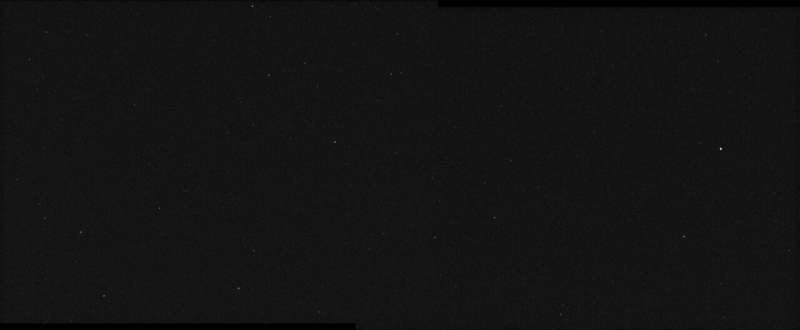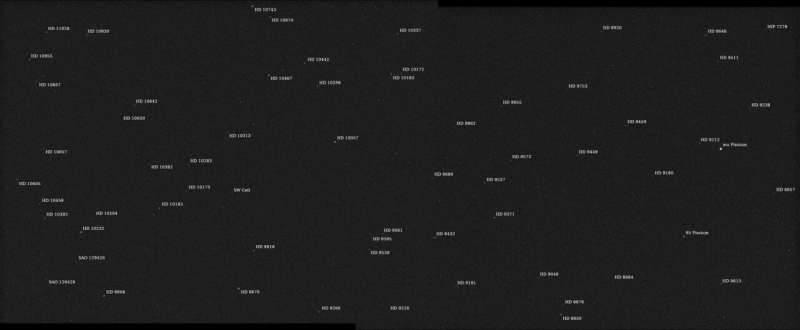This article has been reviewed according to Science X's editorial process and policies. Editors have highlighted the following attributes while ensuring the content's credibility:
fact-checked
trusted source
proofread
NASA's Psyche delivers first images and other data

NASA's Psyche spacecraft is on a roll. In the eight weeks since it left Earth on Oct. 13, the orbiter has performed one successful operation after another, powering on scientific instruments, streaming data toward home, and setting a deep-space record with its electric thrusters. The latest achievement: On Monday, Dec. 4, the mission turned on Psyche's twin cameras and retrieved the first images—a milestone called "first light."

Already 16 million miles (26 million kilometers) from Earth, the spacecraft will arrive at its destination—the asteroid Psyche in the main asteroid belt between Mars and Jupiter—in 2029. The team wanted to test all of the science instruments early in the long journey to make sure they are working as intended, and to ensure there would be plenty of time to calibrate and adjust them as needed.
The imager instrument, which consists of a pair of identical cameras, captured a total of 68 images, all within a star field in the constellation Pisces. The imager team is using the data to verify proper commanding, telemetry analysis, and calibration of the images.
"These initial images are only a curtain-opener," said Arizona State University's Jim Bell, the Psyche imager instrument lead. "For the team that designed and operates this sophisticated instrument, first light is a thrill. We start checking out the cameras with star images like these, then in 2026 we'll take test images of Mars during the spacecraft's flyby. And finally, in 2029 we'll get our most exciting images yet—of our target asteroid Psyche. We look forward to sharing all of these visuals with the public."
The imager takes pictures through multiple color filters, all of which were tested in these initial observations. With the filters, the team will use photographs in wavelengths of light both visible and invisible to the human eye to help determine the composition of the metal-rich asteroid Psyche. The imager team will also use the data to create 3D maps of the asteroid to better understand its geology, which will give clues about Psyche's history.
Solar surprise
Earlier in the mission, in late October, the team powered on the magnetometer, which will provide crucial data to help determine how the asteroid formed. Evidence that the asteroid once had a magnetic field would be a strong indication that the body is a partial core of a planetesimal, a building block of an early planet. The information could help us better understand how our own planet formed.
Shortly after being powered on, the magnetometer gave scientists an unexpected gift: It detected a solar eruption, a common occurrence called a coronal mass ejection, where the sun expels large quantities of magnetized plasma. Since then, the team has seen several of these events and will continue to monitor space weather as the spacecraft travels to the asteroid.
The good news is twofold. Data collected so far confirms that the magnetometer can precisely detect very small magnetic fields. It also confirms that the spacecraft is magnetically "quiet." The electrical currents powering a probe of this size and complexity have the potential to generate magnetic fields that could interfere with science detections. Because Earth has its own powerful magnetic field, scientists obtained a much better measurement of the spacecraft magnetic field once it was in space.
In the zone
On Nov. 8, amid all the work with the science instruments, the team fired up two of the four electric propulsion thrusters, setting a record: the first-ever use of Hall-effect thrusters in deep space. Until now, they'd been used only on spacecraft going as far as lunar orbit. By expelling charged atoms, or ions, of xenon gas, the ultra-efficient thrusters will propel the spacecraft to the asteroid (a 2.2-billion-mile, or 3.6-billion-kilometer journey) and help it maneuver in orbit.
Less than a week later, on Nov. 14, the technology demonstration built into the spacecraft, an experiment called Deep Space Optical Communications (DSOC), set its own record. DSOC achieved first light by sending and receiving optical data from far beyond the moon. The instrument beamed a near-infrared laser encoded with test data from nearly 10 million miles (16 million kilometers) away—the farthest-ever demonstration of optical communications.
The Psyche team has also successfully powered on the gamma-ray detecting component of its third science instrument, the gamma-ray and neutron spectrometer. Next, the instrument's neutron-detecting sensors will be turned on the week of Dec. 11. Together those capabilities will help the team determine the chemical elements that make up the asteroid's surface material.
Provided by NASA




















